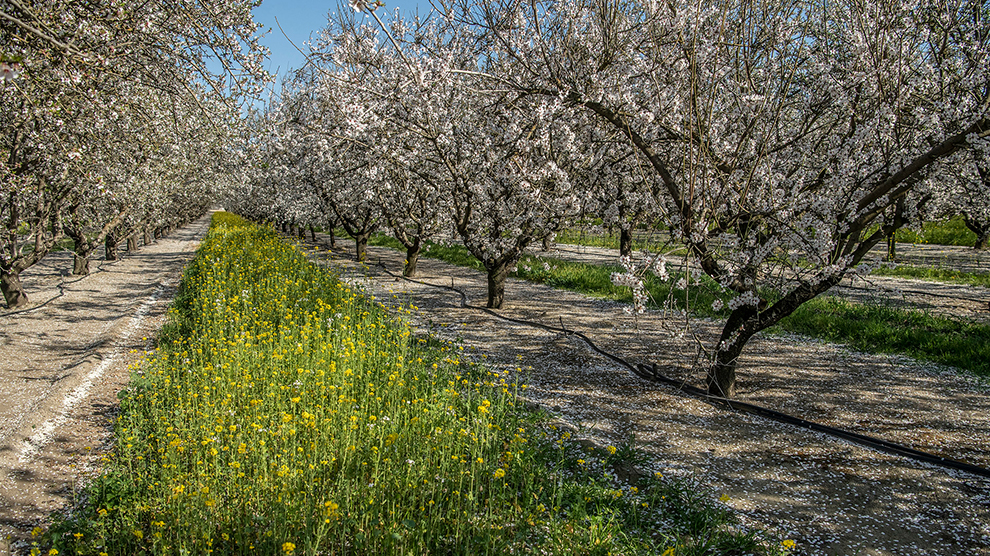Spearheaded by the Almond Board of California (ABC), a new coalition of agricultural and conservation groups will work to encourage more voluntary, grower-friendly efforts to protect the state’s native insect pollinators and managed honeybees.
The California Pollinator Coalition includes a broad array of more than 20 of the state’s leading agricultural organizations and conservation groups (complete list below). The Coalition will focus on increasing grower participation in projects to provide habitat and forage for pollinators and other beneficial insects across the state’s agricultural landscape.
“California’s almond industry has a long record of continuing improvement in the area of Integrated Pest Management and protection and stewardship of managed bees,” said Dr. Josette Lewis, Chief Scientific Officer for ABC. “This new coalition helps us expand on our work to benefit California’s many native pollinator species. We’ll also get more results by collaborating within the agriculture and conservation communities on voluntary efforts that benefit both growers and the environment. Improving the health or our ecosystems is not something we can do alone, so we are glad to have many strong allies in this.”
Convened by Pollinator Partnership, the California Department of Food and Agriculture and the Almond Board of California, the Coalition’s goal is to increase habitat for pollinators on working lands to benefit biodiversity and food production through on-farm and in-orchard projects, supported by technical guidance, research, and documenting progress toward increasing healthier pollinator habitats.
“What we are doing in California is acknowledging the urgency to address the critical issue of protecting all pollinators, including native and managed species,” said President and CEO of Pollinator Partnership Laurie Davies Adams. “Agriculture and conservation must work together to achieve this goal.”
“The outcome will not be a tidy report that sits on a shelf, but rather a metric of acres, projects, and species added to the landscape while agriculture continues to profitably feed the nation,” Adams said.
Extending the California almond industry’s commitment to protect honeybees during almond pollination, the Coalition plans to address habitat issues on an unprecedented scale for the benefit of the state’s beneficial insects, which include 1,600 species of native bees, managed honeybees, butterflies, beetles, wasps, and more. Populations of many California pollinators are declining and often suffer from the same challenges as California’s agriculture.
The Coalition will work together on a variety of fronts to support pollinators:
- Preparing grower-friendly guidance to build and maintain pollinator habitat on farms and ranches
- Conducting research and disseminating relevant science
- Monitoring outcomes (adoption rates and effectiveness of practices)
“Collaborative action can mitigate risks to California’s pollinators, and that’s exactly why this coalition has come together,” said Karen Ross, Secretary of California Department of Food and Agriculture. “We need urgent action, yet the first step in the process is building trust that encourages, enables, and enhances the result. The California Pollinator Coalition is a big step forward in a journey of grower and conservation groups voluntarily demonstrating leadership.”
“This will not be an easy or quick fix,” Lewis said. “It will require a robust and sustained effort, but we are determined to be part of the solution. Almond growers and many other farmers depend on pollinators to produce a crop and pollinators depend on us to provide safe habitat. Working lands can and should be part of the solution.”
“Farm Bureau supports voluntary, farmer-friendly efforts to improve habitat for native pollinators, and we have long advocated improved research on pollinator health,” said President of the California Farm Bureau Jamie Johansson. “We will work with the coalition for the benefit of native pollinators and managed bees, and to assure stability for the domestic bee business.”
While just beginning its work, the Coalition is continuing to recruit partners who understand the urgency and share the common goal of supporting both the health of pollinators and agriculture. Current California Pollinator Coalition membership includes:
- Agricultural Council of California
- Almond Alliance of California
- Almond Board of California
- California Alfalfa and Forage Association
- California Association of Pest Control Advisers
- California Association of Resource Conservation Districts
- California Cattlemen’s Association
- California Citrus Mutual
- California Department of Food and Agriculture
- California Farm Bureau Federation
- California State Beekeepers Association
- California Sustainable Winegrowing Alliance
- Environmental Defense Fund
- Monarch Joint Venture
- Monarch Watch
- Pollinator Partnership
- Project Apis m.
- University of California Agriculture and Natural Resources
- USDA Natural Resources Conservation Service of California
- Western Growers
- Dr. Neal Williams, University of California, Davis
###
About the California Pollinator Coalition
The California Pollinator Coalition, convened by Pollinator Partnership, the California Department of Food and Agriculture and the Almond Board of California, is made up of a diverse group of agricultural and conservation organizations with the shared goal of providing enhanced habitat for pollinators. The Coalition and its members have pledged to increase habitat for pollinators on working lands. Additionally, the group plans to promote research and track its progress toward healthy and abundant habitats.


